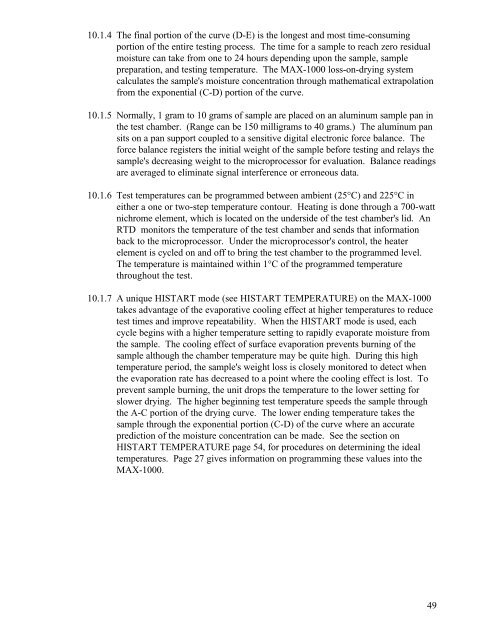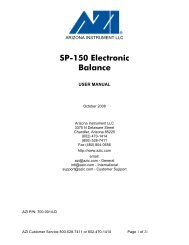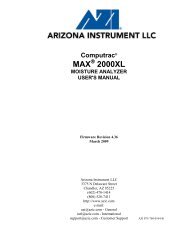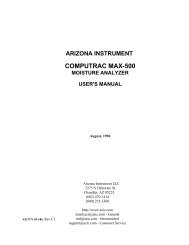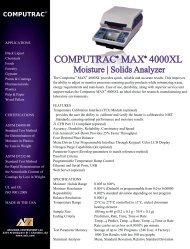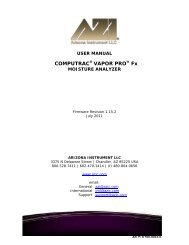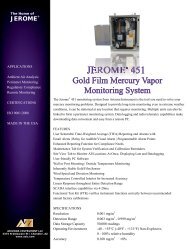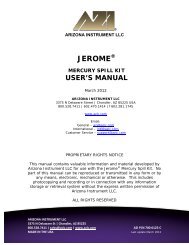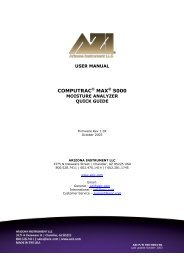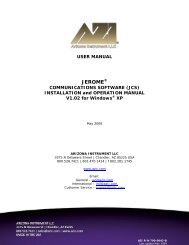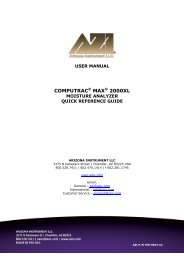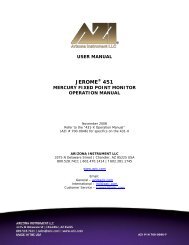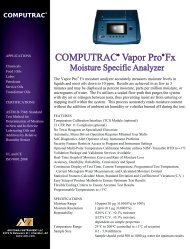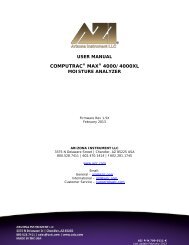Computrac MAX-1000 User's Manual - Arizona Instrument
Computrac MAX-1000 User's Manual - Arizona Instrument
Computrac MAX-1000 User's Manual - Arizona Instrument
Create successful ePaper yourself
Turn your PDF publications into a flip-book with our unique Google optimized e-Paper software.
10.1.4 The final portion of the curve (D-E) is the longest and most time-consumingportion of the entire testing process. The time for a sample to reach zero residualmoisture can take from one to 24 hours depending upon the sample, samplepreparation, and testing temperature. The <strong>MAX</strong>-<strong>1000</strong> loss-on-drying systemcalculates the sample's moisture concentration through mathematical extrapolationfrom the exponential (C-D) portion of the curve.10.1.5 Normally, 1 gram to 10 grams of sample are placed on an aluminum sample pan inthe test chamber. (Range can be 150 milligrams to 40 grams.) The aluminum pansits on a pan support coupled to a sensitive digital electronic force balance. Theforce balance registers the initial weight of the sample before testing and relays thesample's decreasing weight to the microprocessor for evaluation. Balance readingsare averaged to eliminate signal interference or erroneous data.10.1.6 Test temperatures can be programmed between ambient (25°C) and 225°C ineither a one or two-step temperature contour. Heating is done through a 700-wattnichrome element, which is located on the underside of the test chamber's lid. AnRTD monitors the temperature of the test chamber and sends that informationback to the microprocessor. Under the microprocessor's control, the heaterelement is cycled on and off to bring the test chamber to the programmed level.The temperature is maintained within 1°C of the programmed temperaturethroughout the test.10.1.7 A unique HISTART mode (see HISTART TEMPERATURE) on the <strong>MAX</strong>-<strong>1000</strong>takes advantage of the evaporative cooling effect at higher temperatures to reducetest times and improve repeatability. When the HISTART mode is used, eachcycle begins with a higher temperature setting to rapidly evaporate moisture fromthe sample. The cooling effect of surface evaporation prevents burning of thesample although the chamber temperature may be quite high. During this hightemperature period, the sample's weight loss is closely monitored to detect whenthe evaporation rate has decreased to a point where the cooling effect is lost. Toprevent sample burning, the unit drops the temperature to the lower setting forslower drying. The higher beginning test temperature speeds the sample throughthe A-C portion of the drying curve. The lower ending temperature takes thesample through the exponential portion (C-D) of the curve where an accurateprediction of the moisture concentration can be made. See the section onHISTART TEMPERATURE page 54, for procedures on determining the idealtemperatures. Page 27 gives information on programming these values into the<strong>MAX</strong>-<strong>1000</strong>.49


